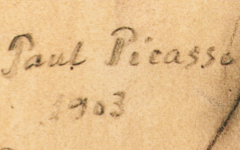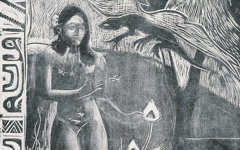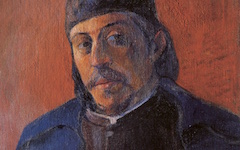Gauguin’s Stéphane Mallarmé (1891)
It is little appreciated by conventional theorists that artists are not photographers illustrating the exterior world but visual poets illuminating the interior one. Consider, for instance, Gauguin’s portrait of the French poet, Stéphane Mallarmé. Henri Dorra, a scholar interested in symbolism, merely noted that “Gauguin and Mallarmé developed a strong mutual respect, memorialized by the artist” in the etched portrait below.1 To Dorra, it is a mere record of the poet's features. Is that art?
Dorra, whose idea of symbolism hardly scratches the surface here, described the raven above the poet’s head as an allusion to Mallarmé’s translation of Edgar Allen Poe’s The Raven. It was inspired, he added, by Edouard Manet’s poster advertising the translation. Why would Gauguin refer to a translation by Mallarmé of another poet’s poem rather than one of Mallarmé’s own works?
Click next thumbnail to continue

Left: Detail of Portrait of Stéphane Mallarmé (Jan. 1891)
Right: Gauguin, Detail of Portrait of the Artist with an Idol (before March 1891)
Click image to enlarge.
Only when you discover that Gauguin’s Mallarmé is the spitting image of Gauguin himself does the raven make sense as a reference to Manet, Gauguin’s great forebear. It's worth noting, too, that both images at left were done within a couple of months of each other.
Click next thumbnail to continue
Seen in this light, Gauguin imagines himself as Mallarmé under the influence of Manet, who had likewise imagined himself as Edgar Allen Poe. Gauguin as a poet-painter has the earlier poet-painter in his mind. As for the surface meaning, it suggests that Mallarmé's mind is filled with Edgar Allen Poe’s poetry. Either way, this is not a photograph.
More Works by Gauguin
Here is a very obvious example of one artist's identification with another

Picasso’s Female Nude in Profile (1902)
Notes:
1. Henri Dorra, The Symbolism of Paul Gauguin (University of California Press) 2007, p. 157
Original Publication Date on EPPH: 08 Nov 2010. | Updated: 0. © Simon Abrahams. Articles on this site are the copyright of Simon Abrahams. To use copyrighted material in print or other media for purposes beyond 'fair use', you must obtain permission from the copyright owner. Websites may link to this page without permission (please do) but may not reproduce the material on their own site without crediting Simon Abrahams and EPPH.




